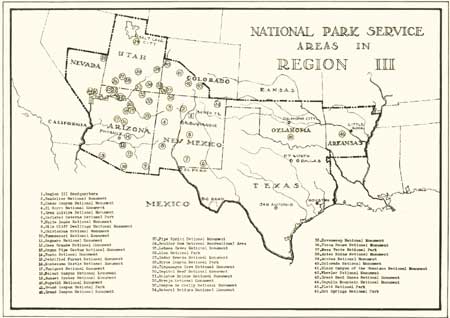|
ODDITIES
A beaver can't misbehave in a national park and "get
away with it." One that was having a gay time cutting down shade trees
at Phantom Ranch, in the depths of Grand Canyon, was disciplined. After
he was caught in a live trap that had been sent down from the canyon
rim, he was placed in a specially constructed box and transported 5
miles by muleback to Wall Creek, where he was liberated in an isolated
beaver colony. The Wall Creek area in the park is reserved for these
little animals. They have the privilege there of cutting down trees,
building dams, and otherwise leading natural lives.
The Trail Ridge Road in Rocky Mountain National Park,
Colorado, is one of the highest and most spectacular automobile roads in
America. Its 4-mile section, at an altitude above 12,000 feet, is
probably the longest stretch of road in the United States at such a
height.
A big increase in the jackrabbit population in Gran
Quivira National Monument, New Mexico, was followed by an influx of
Great Horned Owls. These "tigers of the air", swift in flight, and with
razor-like talons, are vicious in attack. The ranks of the jackrabbits
were quickly thinned - another example of Nature maintaining a
biological balance.
The place that gave Francis Scott Key the inspiration
to write a song that was to become - more than 100 years later - our
national anthem, is now the Fort McHenry National Monument and Historic
Shrine, in Baltimore, Maryland. Key, under a flag of truce, had sailed
from Baltimore, in 1814, to intercede for the release of a friend who
had been captured by the British. Key was detained aboard ship by the
invaders, and witnessed the naval attack on Fort McHenry. He noted, "by
the dawn's early light", after more than a day's bombardment, "that our
flag was still there", and started writing the Star Spangled Banner,
which the Congress, in 1931, formally adopted as the national
anthem.
The agility of an Alpine goat must have been required
by prehistoric Indians who lived in cliffside caves in Frijoles Canyon,
in the present Bandelier National Monument, near Santa Fe, New Mexico.
The only "steps" leading to some of those homes were notches cut with
stone axes into the canyon wall. Water, wood, and the vegetables that
were grown along Frijoles Creek had to be carried up that "trail."

National Park Service Areas in Region III.
(click on image for an enlargement in a new window)
|

